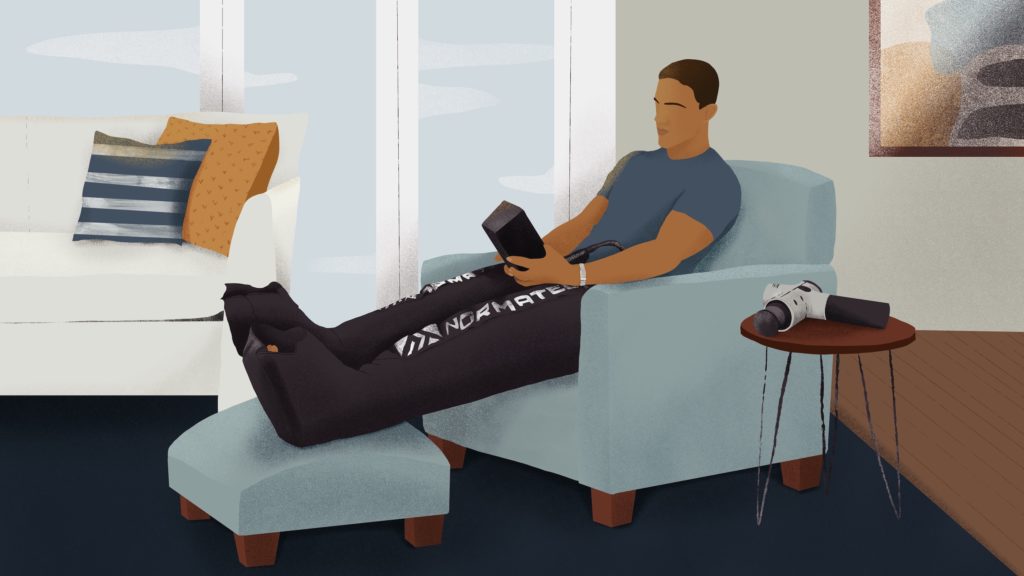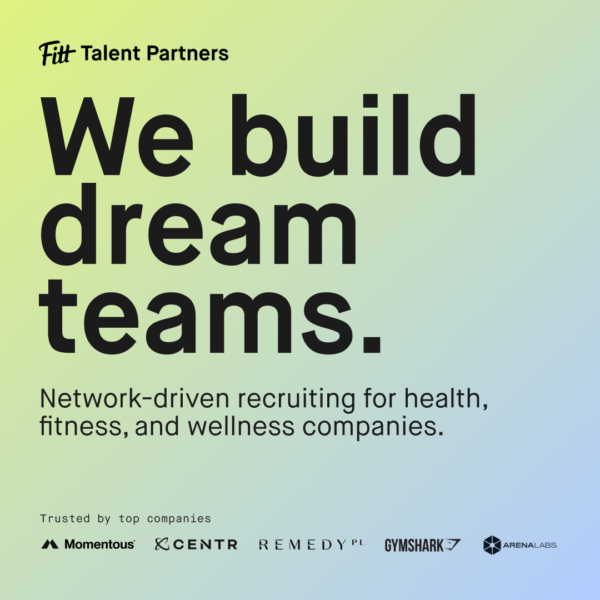A few weeks back, Hyperice raised $48M. More impressive, the recovery tech company earned a $700M valuation.
If that valuation came as a surprise, just wait. The rise of recovery will create a multi-billion-dollar category, giving way to a new class of unicorns.
What is Recovery?
A subcategory of exercise science, recovery is an umbrella term for the restoration of physiological and psychological processes.
Whether it’s athletic competition or intense exercise, physical exertion induces fatigue. In an effort to reduce soreness, restore function, and enhance performance, recovery is an essential element of the training-adaptation cycle.
But physical regeneration is only one variable. A host of stressors, including nutrition, sleep, and mental health, can hinder success. Recognizing this fact, frontrunners and newcomers are seizing on this moment.
Far from ice baths alone, recovery is being redefined. From percussion therapy and compression systems to specialized supplements, electrical stimulation, and infrared saunas, anything goes in the pursuit of high performance.
Trickle-down Health
The recovery craze kicked off with professional athletes. An investment in themselves and their future earnings, athletes like LeBron James, Russell Wilson, and Tom Brady spend millions on their workout and recovery routines.
- Tom Brady’s diet program runs an estimated $16,000/yr.
- LeBron James reportedly spends $1.5M/yr to maintain his body.
- Russell Wilson devotes more than $1M/yr to keeping his body in peak playing shape.
Searching for an edge, athletes are incentivized to find the next best [legal] performance enhancer. With that, recovery-focused companies like Hyperice tailored their products to the highest end of the market.
With buy-in from world-class athletes, the benefits are vast. From beta-tester and brand evangelist to full-fledged athlete-investor, a co-sign from a sports pro can validate a product, drive awareness, and generate demand.
But athletes are just the beginning; recovery wants a piece of the trillion-dollar wellness pie.
Taking a Tesla-like approach to trickle-down technology, where expensive early models pave the way for more affordable electric vehicles, recovery tech sees trickle-down health as a path to mainstream appeal.
Recovery For All
Increasingly, fitness enthusiasts see preparing for and recovering from exercise as essential as the workout itself.
Pre-COVID, stretching studios like Xponential Fitness’s StretchLab benefited, opening 80 locations across the country. Similarly, dedicated recovery studios we’re cropping up. From massage chairs and infrared saunas to supplements and CBD, spots like NYC’s ReCOVER popped up.
A step further, whether it’s ROMWOD, The Ready State, or MVMNT, mobility is becoming a form of daily maintenance. Along these lines, tools like Hyperice’s percussion gun, NormaTec’s compression system, and Recoup’s Cryosphere and Cryosleeve combo are increasing access to protocols traditionally administered by athletic trainers.
A convergence of trends, wearables have honed in on recovery as well.
“There are secrets your body is trying to tell you that WHOOP is now able to measure… the data is better at predicting your level of performance than your own intuition.” — Will Ahmed, WHOOP
As WHOOP CEO Will Ahmed told us on the Fitt Insider podcast, his company’s wrist-worn tracker was born out of his interest in “training optimally, recovery, sleep, and injury prevention.” Perfectly positioned for the rise of recovery, WHOOP could become the category’s next billion-dollar brand.
Elsewhere, the pioneer of sleep fitness, Eight Sleep, is a fast-becoming the recovery mattress of choice among athletes and high-performers.
Be On The Lookout
Initially, icing sore joints and popping ibuprofen was thought to be a cure-all. Then, hyperbaric chambers, cryotherapy, contrast therapy, and other treatments were adopted. More than ever, sports drinks and nutritional supplements are part of the equation. But now, innovation is pushing the boundaries of performance and recovery.
- The sports technology market is expected to reach $31B by 2024.
- Behind fan engagement, athletic performance tech is expected to be among the fastest-growing sectors.
Promising unparalleled results, these emerging technologies are transforming the way we approach and bounce back from training and competition:
Recover Athletics. Boston-based Recover Athletics has created a personalized injury prevention app for runners.
Humon. Using a wearable sensor, algorithm, and app, Humon measures oxygen in a user’s muscles as they train, then visualizes the data.
Amp Human. Rooted in research and sports science, Amp Human’s PR Lotion uses proprietary skin absorption technology to reduce lactic acid buildup in muscles.
InsideTracker. Personalizing performance, InsideTracker uses blood testing and DNA analysis to make custom nutrition, supplement, and lifestyle recommendations.
PowerDot. Electrical muscle stimulation (e-stim) is a staple of physical therapy. PowerDot’s lightweight setup and smartphone app make the treatment more accessible.
Athos. Combining wearables and electromyography, Athos’ smart apparel uses AI to deliver muscle activity insights.
Injury prevention. From load management to movement analytics, startups are trying to reduce injuries and increase durability. Sparta Science ($25.7M in funding), Kitman Labs ($24.5M), Catapult Sports (U/A), Orreco ($4.5M), and Zone7 ($2.5M) are making headway here.
Hydration. Going beyond sugary sports drinks like Gatorade, companies like Liquid I.V. and Nuun are foreshadowing of the evolution of hydration — this category will see more innovation geared towards athletics and training.
Does It Work?
Between stretching, icing, or sipping a protein shake, the science doesn’t always back up the supposed benefits of tried-and-true recovery practices.
According to science writer Christie Aschwanden, author of Good to Go, “the research on most recovery modalities is thin and incomplete.” Which begs the question: Is the rise of recovery moving us closer to peak performance or simply causing us to obsessive over competition?
While the latter could make sense for an Olympic athlete, it’s probably over the top for the everyday exerciser. Why, then, do we spend countless hours and thousands of dollars on recovery? To feel better, of course.
Recovery has become inseparable from performance. And like wellness, the perception and pursuit of well-being, or in this case, progress, are well worth the effort or expense.
🎙On The Podcast
This week on the Fitt Insider podcast, we’re joined by L Catterton managing partners Michael Farello and Jon Owsley.
In addition to investments in consumer brands across almost every category, L Catterton has been heavily involved in the fitness space, investing in Equinox, ClassPass, Peloton, Tonal, Hydrow, and many others.
In this episode, we take a deep dive into the future of fitness, including:
- the growth of and ceiling on connected fitness
- the post-pandemic outlook for gyms and boutique studios
- how L Catterton is able to back so many fitness companies
- where tech companies like Apple and Amazon fit in the category
Listen to the full episode here.
🚨 Warning Signs
Digital and at-home fitness are booming, but our health habits are hurting. Across the board, the pandemic has negatively impacted almost every measure of good health.
Publishing in the journal Obesity, a new study linked stay-at-home orders to increases in unhealthy eating, trouble falling asleep, decreased physical activity, increased sedentary habits, and elevated anxiety levels.
A survey conducted by Morning Consult found that 35% of US adults said they’ve gained weight since the coronavirus pandemic began.
Separately, a survey commissioned by supplement maker Optimum Nutrition found that 62% of Americans are concerned with their overall health.
- 51% of respondents are exercising less than before the pandemic.
- 45% report gaining weight, with 42% saying they are eating less healthy choices.
- 85% say barriers including lack of motivation, financial resources, or insufficient equipment will prevent them from getting healthier.
Making matters worse, as we previously pointed out, burnout and anxiety are on the rise, intensifying the mental health crisis.
Looking ahead: The long-awaited arrival of a COVID vaccine is merely the first step in repairing the damage done to our health during the pandemic.
⚖️ An Industry In Flux
Keeping tabs on the news coming out of the fitness industry has become a daily task. In the latest round of developments, here’s what you need to know…
Orangetheory Fitness is $750K behind in rent at its SoHo studio. The rent is $38K/month and will increase to $45K/month in the future. The studio has reopened but is operating at 33% capacity.
Luxury gym operator Equinox is being sued for more than $1.3M in back rent for its West Village location. The landlord claims the gym operator has defaulted on its rent payments since March.
- The gym chain recently enlisted legal and financial advisers to manage $1.1B in debt obligations, including a February 2021 deadline to repurchase at least $72.8M of SoulCycle debt.
Life Time, the operator of high-end gyms in affluent suburbs, will suffer $500M–$600M in pandemic-related losses in 2020.
- CEO Bahram Akradi said the gym chain expects to lose another $200M in 2021. And doesn’t expect business to begin to recover for seven more months.
Technogym, the Milan-based equipment manufacturer and supplier to gyms, hotels, and spas in 100 countries, is turning its attention to the home.
- Technogym saw direct-to-consumer (DTC) sales of equipment and training programs increase by 50% in the first half of 2020. DTC now accounts for 30% of its revenues, twice that of 2019.
Peloton CFO Jill Woodworth said the company has a plan to grow beyond the pandemic. Broadening its member base will be key to accelerating growth.
- Income. In 2014, 29% of Peloton members had a household income under $100K — a number that jumped to 46% in 2020.
- Age. Also in 2014, 16% of Peloton members were under 35. In 2020, that demographic makes up 31% of the company’s member base.
📰 News & Notes
- adidas set to sell Reebok.
- This Tracksmith x Ciele collab.
- Gap will double down on Athleta.
- Tonal deploys software updates like Tesla.
- OLIPOP’s drink subscription accelerated growth.
- Tom Brady taps IMG to grow his TB12 wellness brand.
💰 Money Moves
- German bike manufacturer Canyon Bicycles is pursuing a sale expected to top €500M ($592M), with private equity firms The Carlyle Group and KKR showing interest. More from Fitt Insider: Parks and Rec
- TPG Growth acquired SmartSweets, a Canadian low-sugar candy maker, for $360M.
- MindLabs, a London-based mental health startup, secured £1.4M ($1.8M) in a pre-seed funding round led by Passion Capital ahead of its digital platform launch. More from Fitt Insider: Erasing Stigmas
- Psychedelic wellness startup Journey Colab raised $3M in strategic funding from Apollo Projects to create health programs using hallucinogenic compound mescaline. More from Fitt Insider: Psychedelic Wellness
- Strydal, a digital platform empowering yoga instructors and fitness creators to produce online classes, received €800K ($946K) in pre-seed funding. More from Fitt Insider: Arming the Rebels
- Healthtech company GoodCell raised $17.9M in preferred equity to support its research in preventive medicine and scale its platform using big data to predict human longevity.
- Oula, a maternity care startup, closed a $3.2M seed round led by Collaborative Fund with participation from Rock Health, Female Founders Fund, and others. More from Fitt Insider: Women’s Health Revolution
- Women’s emotional support app Clementine raised €1.1M ($1.3M) in new funding.
- Love Good Fats, a Canadian producer of ketogenic smoothies and snack bars, secured $10.7M to increase its footprint in North America.
- Eco-friendly personal care startup Wild Cosmetics received €2.2M ($2.6M) in a seed round led by JamJar Investments.
- Proper Wild, makers of a plant-based energy shot, raised $3M in a funding round to launch its product in brick-and-mortar stores.
- RV rental marketplace RVshare raised over $100M in a funding round led by KKR. More from Fitt Insider: Glamping, the Next Wave of Wellness
- Thule Group, a Swedish manufacturer of outdoor and sports cargo products, reported 44.9% YoY growth in Q3 net sales.
 Courtney Powell
Courtney Powell
